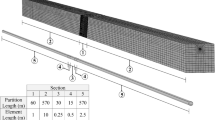Abstract
Seismic ground faulting is the greatest hazard for continuous buried pipelines. Over the years, researchers have attempted to understand pipeline behavior mostly via numerical modeling such as the finite element method. The lack of well-documented field case histories of pipeline failure from seismic ground faulting and the cost and complicated facilities needed for full-scale experimental simulation mean that a centrifuge-based method to determine the behavior of pipelines subjected to faulting is best to verify numerical approaches. This paper presents results from three centrifuge tests designed to investigate continuous buried steel pipeline behavior subjected to normal faulting. The experimental setup and procedure are described and the recorded axial and bending strains induced in a pipeline are presented and compared to those obtained via analytical methods. The influence of factors such as faulting offset, burial depth and pipe diameter on the axial and bending strains of pipes and on ground soil failure and pipeline deformation patterns are also investigated. Finally, the tensile rupture of a pipeline due to normal faulting is investigated.
Similar content being viewed by others
References
Ariman T and Lee BJ (1991), “Tension/Bending Behavior of Buried Pipelines under Large Ground Deformation in Active Faults,” Proceedings, 3rd US Conference on Lifeline Earthquake Engineering; Technical Council on Lifeline Earthquake Engineering; ASCE Monograph, 4: 226–233.
Audibert JME and Nyman KJ (1977), “Soil Restraint Against Hhorizontal Motion of Pipes”, ASCE J Geotechnical Engineering Division, 103(GT10): 1119–1142.
Brockenbrough RL (1990), “Strength of Bell-and-spigot Joints”, J. Structural Engineering, 116(7): 1983–1991.
Dickin EA and Leuoy CF. (1983), “Centrifuge Model Tests on Vertical Anchor Plates,” ASCE J Geotechnical Engineering, 109(12): 1503–1525.
Ghalandarzadeh A (1997), “Shaking Table Tests on Seismic Displacement of Water-front Structures,” PhD Dissertation, University of Tokyo, Japan.
Ha D, Abdoun TH, O’Rourke MJ, Symans M, O’Rourke TD, Palmer MC and Stewart HE (2008), “Centrifuge Modeling of Earthquake Effects on Buried Highdensity Polyethylene (HDPE) Pipelines Crossing Fault Zone,” ASCE J Geotechnical and Geoenvironmental Engineering, 134: 1501–1515.
Kennedy RP, Chow AW and Williamson RA (1977), “Fault Movement Effects on Buried Oil Pipeline,” ASCE J. Transportation Engineering Division,103(TE5): 617–633.
Liu X and O’Rourke MJ (1997), “Behaviour of Continuous Pipeline Subject to Transverse PGD,” Earthquake Engineering and Structural Dynamics, 26: 989–1003.
Meyersohn WD (1991), “Analytical and Design Considerations for the Seismic Response of Buried Pipelines,” Graduate thesis, Cornell University.
Moncarz PD, Shyne JC and Derbalian GK (1987), “Failure of 108-inch Steel Pipe Water Main,” ASCE J Performance of Construction Facilities, 1(3): 168–187.
Newmark NM and Hall WJ (1975), “Pipeline Design to Resist Large Fault Displacement,” Proceedings, US National Conference on Earthquake Engineering, Ann Arbor, Michigan; Paper UILU-ENG-75-2011: 416–425.
O’Rourke M, Gadicherla V and Abdoun T (2005), “Centrifuge Modeling of PGD Response of Buried Pipe,” Earthquake Engineering and Engineering Vibration; 4(1): 69–73.
O’Rourke M and Liu X (1999), Response of Buried Pipelines Subject to Earthquake Effects, Multidisciplinary Center for Earthquake Engineering Research (MCEER), Monograph Series, pp. 250.
Ovesen NK (1981), “Centrifuge Tests of the Uplift Capacity of Anchors”, Proceedings, 10th International Conference on Soil Mechanics and Foundation Engineering, Stockholm, Sweden, pp.717–722.
Rojhani M, Moradi M, Galandarzadeh A and Takada S (2011a), “Centrifuge Modeling of Buried Pipelines Response due to Reverse Faulting,” Proceedings, 5th international Conference on Earthquake Geotechnical Engineering, Santiago, Chile, Paper No. CMBRO.
Rojhani M, Moradi M, Galandarzadeh A and Takada S (2011b), “Centrifuge Modeling of Buried Pipelines Response due to Normal Faulting,” Proceedings, 14th Asian Regional Conference on Soil Mechanics and Geotechnical Engineering, Hong Kong, China, Paper No. 188.
Rojhani M, Moradi M, Ebrahimi MH, Galandarzadeh A and Takada S (2012a), “Recent Developments in Faulting Simulators for Geotechnical Centrifuges,” Geotechnical Testing Journal, ASTM, 35(6). (In press)
Rojhani M, Moradi M, Galandarzadeh A and Takada S (2012b), “Centrifuge Modeling of Buried Continuous Pipelines Subjected to Reverse Faulting,” Canadian Geotechnical Journal, 49(6): 659–670.
Takada S (1984), “Model Analysis and Experimental Study on Mechanical Behavior of Buried Ductile Iron Pipeline Subjected to Large Ground Deformation,” Proceedings, 8th World Conference on Earthquake Engineering, San Francisco; Vol 7, 255–262.
Takada S, Hassani N and Fukuda K (2001), “A New Proposal for Simplified Design of Buried Steel Pipes Crossing Activ e Faults,” Earthquake Engineering and Structural Dynamics, 30: 1243–1257.
Tawfik MS and O’Rourke TD (1985), “Load-carrying Capacity of Welded Slip Joints,” J Pressure Vessel Technology, 107: 37–43.
Towhata I (2008), Geotechnical Earthquake Engineering, Springer.
Yoshizaki K, O’Rourke TD, Bond T, Mason J and Hamada M (2001), “Large Scale Experiments of Permanent Ground Deformation Effects on Steel Pipelines,” http://mceer.buffalo.edu/publications/resaccom/01-sp01/rpa_pdfs/03orourke_tkyogas.pdf [25 May 2011].
Author information
Authors and Affiliations
Corresponding author
Rights and permissions
About this article
Cite this article
Moradi, M., Rojhani, M., Galandarzadeh, A. et al. Centrifuge modeling of buried continuous pipelines subjected to normal faulting. Earthq. Eng. Eng. Vib. 12, 155–164 (2013). https://doi.org/10.1007/s11803-013-0159-z
Received:
Accepted:
Published:
Issue Date:
DOI: https://doi.org/10.1007/s11803-013-0159-z




